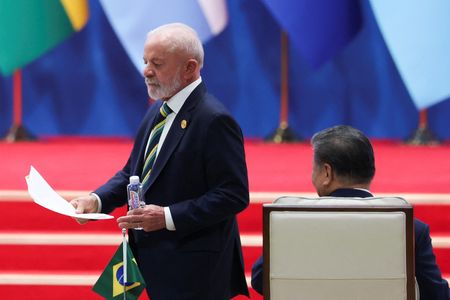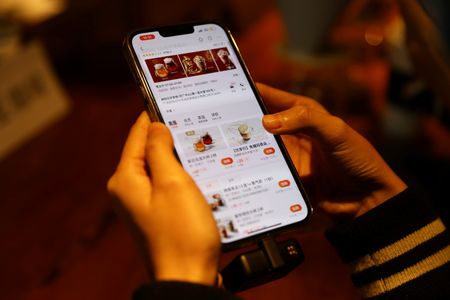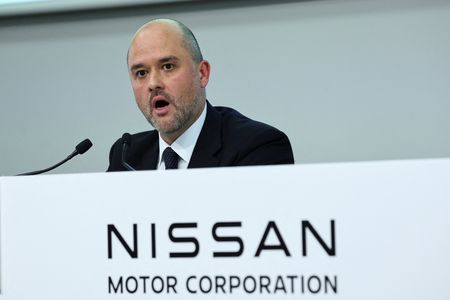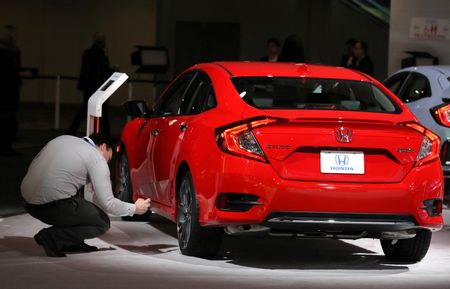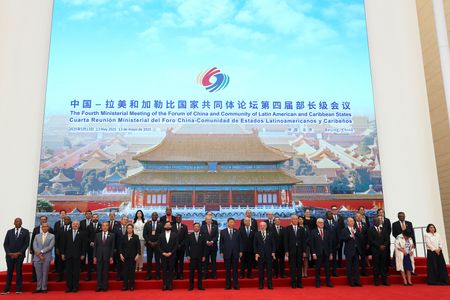By Andrea Shalal
WASHINGTON (Reuters) -Donald Trump’s tariff blitz is yielding some initial deals, including a 90-day pause in sky-high U.S. and Chinese duties and a limited trade pact with Britain, but the U.S. president is far from rebalancing global commerce flows, trade experts and analysts said.
The weekend U.S.-China tariff truce unleashed a surge in global stock prices and may stave off damage from price spikes and critical minerals shortages until August, but does nothing to address longstanding U.S. complaints about China’s state-dominated, export-driven economic model.
Instead, it sets a tight new deadline for complex negotiations with Beijing that will take place alongside talks with dozens of other countries facing an earlier, July 8 deadline to avoid higher tariffs – stretching the Trump administration’s limited negotiating resources.
Some other early Trump trade deals are expected in the coming weeks, with Switzerland, India and Japan likely to lead the pack. But like the British deal, these are expected to be agreements in principle, with more work to finalize them, and durably shifting supply chains and trade flows can take years to accomplish.
“The jury’s still out, and we won’t be able for some time to look back and say this was a successful strategy,” said Greta Peisch, a former senior trade official under President Joe Biden who is now a partner in the Wiley Rein law firm. “This is round one.”
Kelly Ann Shaw, a senior U.S. official during Trump’s first term who is now with the Akin Gump law firm, said Trump deserved credit for bringing China, the UK and other countries to the negotiating table after years of concerns about U.S. trade deficits.
“Whether you agree or disagree with the tactic, at least Trump is thinking outside the box,” Shaw said. “They’re negotiating some of the deals at record speed, and that is not something that has ever happened before.”
WAITING FOR TALKS
Diplomats with the European Union, a top U.S. trade partner that has drawn Trump’s ire, are still waiting for in-depth negotiations to begin.
And it’s unclear how quickly a substantive agreement with China could be reached.
U.S. and Chinese negotiators issued a rare joint statement after two days of meetings in Switzerland, but did not set dates or a venue to meet again. The negotiations will also include measures to curb trafficking of fentanyl, the source of Trump’s 20% duties on Chinese goods.
Democrats and Republicans alike have criticized China for producing too much steel, too many solar panels and other goods and then dumping them in Western markets, but those policies haven’t changed despite repeated entreaties.
China had long proven resistant to changing its economy and allowing more U.S. companies to compete for orders, Peisch said. “You’re up against China’s whole theory of its economic policy and how it is operating in the world,” she said.
Robert Kuttner, co-founder of liberal magazine The American Prospect, said Beijing was not about to jettison its mercantilist system, which benefits from state-led capitalism to create or capture technology and product advantages, “and certainly not in 90 days.”
Even if agreements were eventually reached in which Beijing pledged to reform its intellectual property laws or lower barriers to entry by U.S. firms, assessing compliance would be extremely difficult, Peisch added.
Beijing’s failure to fulfill its commitments to vastly increase purchases of U.S. manufactured and farm goods, energy and services in Trump’s first-term “Phase 1” agreement also remains a sore point, said Ryan Majerus, a trade lawyer who worked under both the Trump and Biden administrations and is now a partner at King & Spalding.
“This is a positive development, but the devil is in the details on where the talks go from here,” Majerus said. “We have a lot of longstanding trade concerns with China where the administration will want to see meaningful commitments.”
UNCERTAINTY REIGNS
Miriam Sapiro, a nonresident fellow at the Center for Strategic and International Studies and former acting USTR chief under then-President Barack Obama, said long-term solutions were needed to resolve deep U.S.-China trade differences, but it would be nearly “nearly impossible” to address non-tariff barriers on the compressed 90-day time line.
“What we really need is more consistency. U.S. companies need to be able to plan instead of scramble to reroute supply chains, which can be difficult to do quickly. And American families are quite spooked by the impact these and other tariffs are going to have on their pocketbook,” she said.
Matt Priest, President and CEO of the Footwear Distributors and Retailers of America, agreed the deal marked a good step toward easing tensions, but said high tariffs remained in place on some Chinese imports, including some shoes facing duties approaching 90%.
“We’re not across the finish line yet.”
(Reporting by Andrea Shalal; additional reporting by Lisa Baertlein in Los Angeles; editing by David Lawder and Lincoln Feast.)


